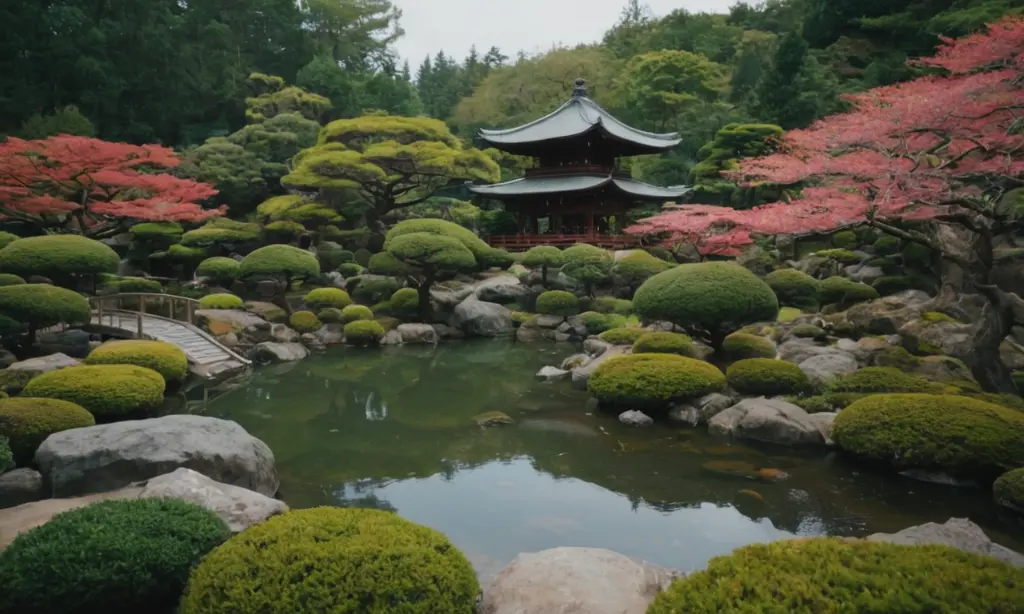
Japanese Garden: Embrace Zen Aesthetics and Nature’s Serenity
Japanese gardens are captivating spaces that blend natural elements with artistic design. Rooted in Zen Buddhism and ancient traditions, these gardens offer tranquility, simplicity, and a profound connection to nature. Let’s explore the essence of Japanese Zen gardens and their timeless appeal.
The Beauty of Stones
Stones play a central role in Japanese gardens. The sekitei, or rock gardens, exemplify the beauty of stones. These expanses of raked white gravel feature strategically placed rocks. According to 19th-century writer Lafcadio Hearn, understanding the beauty of Japanese gardens requires appreciating the beauty of stones.
Zen Philosophy and Garden Design
Zen Buddhism profoundly influenced Japanese garden design. During the Kamakura Era (1185-1333), Zen teachings emphasized meditation, mindfulness, and simplicity. Samurai warriors, who embraced Zen, found solace in tea ceremonies and landscape gardening. Ueda Soko, a samurai and landscape designer, created the stunning Shukkeien Garden in Hiroshima, blending Zen aesthetics with natural beauty.
Wabi-Sabi Aesthetics
At the heart of Japanese garden design lies the principle of Wabi-Sabi. Wabi-Sabi celebrates imperfection, simplicity, and the beauty of natural materials. In these gardens, asymmetry, weathered textures, and organic forms evoke a sense of serenity and acceptance. Wabi-Sabi encourages us to appreciate the transient and imperfect aspects of life.
Harmony with Nature
Japanese gardens harmonize with their surroundings. Water features, such as ponds and streams, symbolize life and flow. Bridges connect different areas, inviting contemplation. Every element—rocks, plants, lanterns—coexists harmoniously, reflecting the interconnectedness of all things. These gardens encourage mindfulness and a deep appreciation for nature.
How can I create a small Zen garden at home?
Creating a small Zen garden at home is a wonderful way to bring tranquility and mindfulness into your space. Here are four easy steps to get you started:
- Choose Your Container and Fill It With Sand:
- Select a container you love—a shallow tray, a bonsai pot, or even a wooden box.
- Fill the container with fine sand or aquarium substrate. The sand represents the calming waves or ripples in a traditional Zen garden.
- Add Decorative Stones or Crystals:
- Place smooth stones or crystals strategically on the sand. These represent islands or mountains in your miniature landscape.
- Arrange them in a balanced and harmonious way, embracing the simplicity of Zen aesthetics.
- Include Air Plants (Tillandsias):
- Air plants are low-maintenance and perfect for Zen gardens.
- Group them in one corner of your container, creating a serene focal point.
- Create Patterns With a Mini Rake:
- Use a small rake (you can make one from chopsticks) to create patterns in the sand.
- Experiment with gentle waves, concentric circles, or straight lines—whatever brings you a sense of calm and focus.
Remember, your Zen garden is a personal expression of tranquility, so feel free to customize it according to your preferences. 🌿🧘♂️🌸
What are the key elements of a Japanese garden?
The key elements of a Japanese garden include:
- Stones and Gravel: Stones symbolize mountains and islands. Raked gravel represents water or waves in rock gardens.
- Water Features: Ponds, streams, and waterfalls create a sense of flow and life.
- Plants: Carefully chosen trees, shrubs, and moss add greenery and seasonal beauty.
- Bridges: Wooden or stone bridges connect different areas, inviting contemplation.
- Lanterns: Stone lanterns serve both practical and symbolic purposes.
- Tea Houses: Tranquil spaces for tea ceremonies and reflection.
- Wabi-Sabi Aesthetics: Embrace imperfection, simplicity, and natural materials.
More about Wabi-Sabi aesthetics
Wabi-sabi is a traditional Japanese aesthetic centered on embracing imperfection and transience. Here are the key points:
- Imperfect Beauty: Wabi-sabi appreciates beauty in imperfection, incompleteness, and flaws.
- Transience: It acknowledges the fleeting nature of existence and celebrates the passage of time.
- Simplicity: Wabi-sabi finds beauty in simplicity, rusticity, and authenticity.
- Asymmetry: It values asymmetry over perfect symmetry.
- Tea Ceremonies: Wabi-sabi is deeply connected to the art of the tea ceremony.
- Zen Gardens: Japanese Zen gardens exemplify wabi-sabi through their natural elements and serene design.
How can I incorporate wabi-sabi into my home decor?
Wabi-sabi is a Japanese philosophy that celebrates imperfection, simplicity, and the natural flow of life. When incorporating wabi-sabi into your home decor, consider the following key principles:
- Be Intentional: Mindfully select items for your home. Each piece should have a purpose and reflect how you want to live your life.
- Weave in Personal Touches: Embrace personal items, vintage pieces, and natural elements. These add authenticity and depth to your space.
- Neutral Earth Tones: Opt for a soft color palette with neutral earth tones. These create a calming and harmonious atmosphere.
- Nature Inside: Bring nature indoors through plants, natural materials, and textures. Wood, stone, and woven fabrics evoke wabi-sabi aesthetics.
- Mismatched Decor: Embrace imperfection by mixing different textures, patterns, and styles. Mismatched decor adds character and warmth.
- Keep What You Love: Declutter and keep only items that truly resonate with you. Let go of excess and focus on meaningful possessions.
Remember, wabi-sabi is about finding beauty in simplicity, imperfection, and the essence of life itself. 🌿🏡🌸
Japanese Zen gardens are more than mere landscapes; they embody spiritual truths, aesthetic sensibilities, and a reverence for nature. Whether you visit a traditional temple garden or create a miniature Zen garden at home, these spaces inspire reflection, peace, and a connection to the natural world.
Remember, as you explore the artistry of Japanese gardens, it’s not just about what you see—it’s about what you feel and experience.
I hope you find this article informative and engaging! If you have any specific requests or need further details, feel free to ask. 🌿🌸🍃



